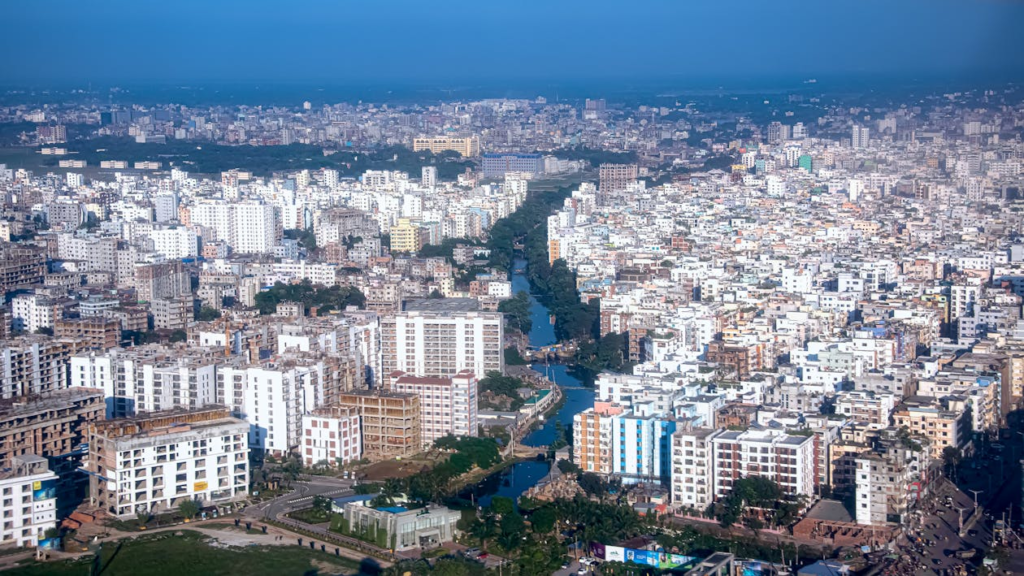Environmentally friendly entities are crucial to promote sustainability, enhance efficiency and improve overall well-being for both the present and future generations. But many public and private entities are not environmentally friendly in Bangladesh, leading to concerns, though the number of such entities is increasing. Many countries are now increasingly considering environmentally friendly entities, both public and private. Despite increased emphasis on environmentally friendly entities all over the world and the growing promotion and incorporation of such entities in Bangladesh especially during the last decade, their lack is because of a variety of reasons including insufficient financial incentives, a lack of robust regulatory frameworks, inadequate implementation, and a lack of motivation for environmentally friendly requirements.
The WASA Padma Water Treatment Plant — a large-scale and the largest surface water treatment facility in Bangladesh — can serve as a model for making public and private entities environmentally friendly for its ecological implications, management, aesthetic appeal and other reasons. While numerous offices are enveloped in dust, sand, and heaps of plastic, the Padma institution of the WASA (the Water Supply and Sewerage Authority of Bangladesh) clearly distinguishes itself through its cleanliness, environmental consciousness and several other aspects. The plant is undoubtedly motivating during these crucial times of environmental and climate change mitigation and adaptation in different countries. The crucial water treatment plant exemplifies the maintenance of natural equilibrium within a technology-reliant sector such as water supply. Climate adaptation exemplifies a good practical application here and the water treatment plant may be designated as a laboratory for nature- based solutions.

Credit: the Author.
The Padma Water Treatment Plant, which I visited when I went to Bangladesh for an official visit with global water and river specialists, is diligently striving to guarantee a consistent provision of this essential clean water, providing service to over ten million individuals in the capital city. Pertinently saying, the plant, a critical asset for the WASA, purifies approximately 450 million liters of water per day and supplies it to the residents of Dhaka. The plant was built in a peaceful environment in the Jashaldia area of Munshiganj’s Louhajang sub-district and covers approximately 100 hectares. It is not merely a substantial purification facility, it seems, based on published sources and my visit, that its significance extends beyond the production of pure water.
This water treatment plant has a vibrant garden, a workplace enveloped in greenery that exemplifies a model for any office campus in Bangladesh. Every flower blooms, and every fruit produces in the plant — recognized as an environmentally friendly green model area — in Bangladesh. Mango, guava, pomegranate, wood apple, lemon, coconut, and other indigenous and exotic fruit trees are abundant. There is also a significantly improved aesthetic appeal of the area due to a variety of flowering trees in clusters, including jarul, krishnachura, radhachura, kanchan, kanakchura, furus, and rajnigandha. In the plant area, birdsong fills the air every morning and the clustered trees promote seasonal enjoyment by blooming nearly all year.
The staff of the Padma Treatment Plant, which exemplifies a genuine green community, is a well-managed large garden and is accountable for this remarkable greening owing to their outstanding dedication and affection. Pertinently saying, they pledge to volunteer in the garden for a minimum of one hour daily following work hours. But for them, it transcends mere employment; it is a pastime and a manifestation of profound passion. Some tend to the trees, while others prune the bushes, eliminate residual leaves and debris, and cultivate new seedlings. Such initiatives have rejuvenated not only the facility but also the intellect of the employees who operate within it.

Dhaka Opinion Magazine is a global/international opinion magazine. It publishes for you all. The magazine publishes with the aim to help address concerns, improve conditions, solve problems and mitigate conflicts all over the world. Your support is important for the esteemed magazine. You can sponsor the magazine and/or donate to it…
Such practices, ranging from designing to caring, are exceedingly rare within the framework of other governmental offices nationwide. The Padma WASA treatment facility, which has become a source of national pride by addressing the clean water requirements of millions through advanced technology and simultaneously fostering a vibrant green environment cultivated by environmentally conscious personnel, and has environmentally friendly and other good aspects, exemplifies one of the best practices for many comparable organizations and will enhance the working environment and significantly contribute to the nation’s greening and environmental conservation initiatives — benefiting many other government and private organizations.
Given that the Padma Water Treatment Plant model serves as a benchmark for many public entities in Bangladesh, its adoption should be promoted in different governmental and private entities. Its practical dimensions of environmental conservation and sustainable development through natural methods can also be particularly helpful for many other entities. Among the others, this water treatment plant may also help broaden the sense of gardening for many and can transcend mere hobby status for many.
DISCLAIMER: The views expressed are those of the authors and do not necessarily reflect the official policy or position of the Magazine and its editorial team. Views published are the sole responsibility of the author(s).

